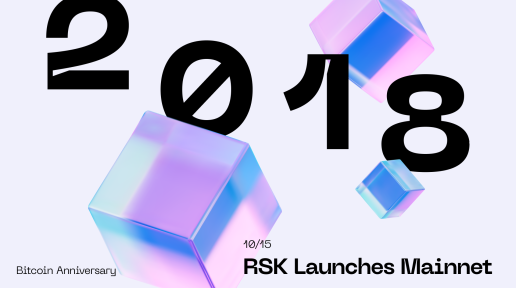Bitcoin's design has long emphasized security and decentralization at the cost of scalability. As a result, over the years many developers and users have flocked to newer blockchains, most notably Ethereum, as it more easily enables decentralized applications and technologies like smart contracts.
So while Bitcoin and Ethereum have both become mainstay blockchain networks in the crypto world, Ethereum has become associated with much of the growth of the Web3 economy. But in 2018, a scalability solution emerged that sought to combine the security and decentralization of the Bitcoin blockchain with the level of utility and scalability found on Ethereum.
That solution was known as Rootstock (RSK), a platform and layer that has become known for its work on integrating smart contracts on Bitcoin.
What is Rootstock (RSK) and Why Did The Bitcoin Sidechain Come About?
RSK labs was co-founded in 2015 by Diego Gutierrez-Zaldivar, Sergio Demian Lerner and several other Bitcoin developers in Argentina who wanted to extend Bitcoin's capabilities that remained true to Bitcoin's principles, but also allowed it to scale. The result was the very first smart contract platform that was a merge-mined sidechain to Bitcoin, rather than a split from either Bitcoin or Ethereum. This implied that RSK might provide Ethereum-compatible smart contracts while making use of Bitcoin's security infrastructure.
The platform launched on mainnet in 2018, during which it also announced its acquisition by RIF Labs (now known as IOV Labs). In essence, the RSK network possesses three key attributes aimed at enhancing Bitcoin:
- Scalability: The Bitcoin network can be expanded via the RSK blockchain. RSK increases the bandwidth of Bitcoin by validating, aggregating, and forwarding transactions to the network's core for final settlement. This allows for a wider range of users, applications, and transaction types.
- Quick transaction processing: RSK can create new blocks about every 33 seconds. Furthermore, RSK can process 10–20 transactions per second, which is a significant improvement over Bitcoin's transaction rate of 5 transactions per second.
- Smart Contract Capability: RSK's smart contracts function independently, doing away with the need for a middleman. As a result of the main layer of Bitcoin's limited programmability, RSK presents the smart contract functionality, opening the door for the creation of decentralized applications on top of the vast Bitcoin ecosystem.
It aims to accomplish all three of these goals with a few key components, including merged mining (the process with which RSK blocks are mined), the Powpeg protocol (a two-way bridge that uses RSK's digital asset, RBTC) and the RSK Virtual Machine, which is based on the Ethereum Virtual Machine (EVM) and allows for the execution of Ethereum smart contracts on Bitcoin.
RSK has already been integrated in a number of wallets, asset swaps and DeFi protocols.
The Impact and Implications: A Broader Perspective on RSK's Mainnet Launch
While RSK's Mainnet launch brought significant improvements to Bitcoin, its combination of Ethereum's creative programmability and Bitcoin's unparalleled security resulted in a number of wider ramifications that changed the blockchain environment. A fair number of developers saw RSK as a platform to build boundary-pushing decentralized apps without compromising the proven protections of Bitcoin's chain.
RSK's increased throughput capabilities also promoted accessibility by removing scalability bottlenecks. More individuals worldwide could possibly participate in blockchain without facing high network congestion or transaction fees. This accessibility, in many people's eyes, would pave the way for more mainstream adoption of Bitcoin and its scaling solutions. Additionally, RSK demonstrated how disparate blockchain technologies could interoperate, pioneering a new era of cross-chain partnerships. Rather than isolated ecosystems, RSK highlighted the power of leveraging the strengths of multiple networks in a demonstration of interoperability.
For Bitcoin miners, RSK was an opportunity to secure both Bitcoin and Ethereum blockchains while benefiting from smart contract fees. By integrating RSK's chain as a merge-mined sidechain, Bitcoin miners could expand their revenue sources without diverting focus from Bitcoin. RSK proved a win-win for sturdier security and miner profitability.
Community sentiment
When RSK announced its plans to introduce and operationalize smart contracts, the broader crypto community anticipated a seamless execution. However, RSK Labs took a different approach. They opted for a semi-trustless federation of signees to oversee the custody of coins being transferred between the Bitcoin main net and the Sidechain.
This structure raised eyebrows due to the inherent risks it presented. With the federation comprising only 25 participants, many in the crypto community viewed this as a potentially vulnerable arrangement, leading to hesitation in fully embracing the platform.
Over the years, the community has grown and there are a number of members that have adopted the technology, actively discuss it in online forums to improve upon its capabilities.
Pioneering Bitcoin’s Next Phase
Ultimately, RSK stands as a testament to the relentless efforts of innovators committed to expanding the horizons of Bitcoin. By integrating the sturdy security infrastructure of Bitcoin with the versatile smart contract functionalities of Ethereum, RSK exemplifies what robust, harmonized solutions in the blockchain realm can resemble.
Furthermore, it encapsulates the diverse applications and opportunities that Bitcoin can harness, an essential evolution for its widespread acceptance. Thus, RSK doesn’t just signify an advanced platform; it represents a monumental stride towards scalability, propelling the momentum of Bitcoin and the broader blockchain ecosystem into the future.

